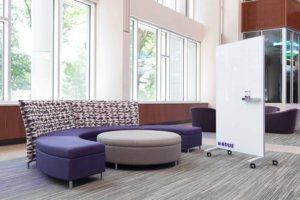Why is an Open Concept Office Furniture Effective?

Why is an Open Concept Office Furniture Effective?
With so many companies working to promote teamwork and boost productivity, open-plan offices are a popular option. The open-concept office design trades conventional barriers like walls and office doors for open space with everyone working closely together. The benefits of an open-concept office range from reduced costs in overhead, better customization to more effective management, and collaboration.
Weighing the advantages against potential drawbacks as well as proper implementation, the open-concept office can be quite effective. Here’s how:
Makes Collaboration Easier
One of the key advantages of an open-concept office is the convenience and ease of communication and collaboration amongst employees. Since workers are not separated by cubicle walls or physical offices, coworkers can easily gather at a common table or work area.
Employees can be more productive since they can easily share ideas and receive frequent feedback on projects and tasks from others. The increased collaboration makes an open-concept office ideal for project-driven work environments as well as co-working spaces for freelancers.
Saving Money on Overhead Costs
Reducing overhead costs is another benefit of open-concept office design. There is no need to purchase expensive cubicle workstations or traditional work desks. Businesses can invest their money into more important areas like product development and marketing.

Easier Employee Management
Without barriers like walls or office doors, it’s easier for supervisors to monitor workers and respond to problems. Managers can stroll around the open-concept office and communicate easily with employees checking their progress on assignments. This can also improve productivity since workers know their managers are watching them. They’ll slack off less under increased supervision.
Employees will also benefit since they have more convenient access to management throughout the day. They don’t have to leave their workspace to walk to their manager’s office. Employees may feel more relaxed approaching management in this open-concept format.
Allows for a Customized Space
Increased flexibility in how the office space can be laid out is among the open-concept advantages. This type of floor plan allows a business to decide the best way to group teams to accomplish goals. If project teams grow, tables can be moved around, allowing for the most effective collaboration. Managers can even change the setup on short notice when necessary. This wouldn’t be possible with fixed walls.

Proper Implementation is Key
While open-concept offices are designed to encourage collaboration and efficiency, poor implementation often leads to the opposite result.
U.S. companies have been swapping cubicles for open-concept offices for over a decade now. Today, more than seventy percent of employees work in shared spaces. Some are fans; many aren’t.
The abundance of open-concept offices has allowed for considerable research on which elements actually boost productivity and happiness and which do not. Many studies show that open-concept offices can stifle productivity, increase both stress and sickness, and, ironically, result in less face-to-face interactions. Some suggest, however, that if implemented “correctly,” open-concept plans will boost productivity and happiness as intended.
So, what have we learned about open-concept offices that can be used to improve upon the model?
Open-Concept Offices Work Best When They Reflect Your Core Values
A survey conducted by the Harvard Business Review discovered that offices were more productive when they reflected what the companies do and how they work. Workers in these offices reported greater happiness and that they worked well together and independently.

Distractions are an Open-Concept’s Downfall
Open concepts increase visibility for coworkers, who can see what others are working on and help when needed. That’s a positive. Gemma Irving, a researcher at the University of Queensland, conducted a study of open-concept offices to see if they irritated or inspired employees. She discovered that “Employees valued getting instant help from their team members in the open-plan. Instead of distractions or having privacy issues, team members could access shared whiteboards, flipcharts and drawings, helping coordination and improve team productivity.”
However, and this is key, those successful open-concept offices included ways for coworkers to guard their individual work time. Methods as simple as “do not disturb” signs posted at their desks when needed. Other research suggests that when private spaces, rooms, and cubes are readily accessible for private work, employees will be happier with their open-concept environment.
Booking Conference Rooms Must be Easy
Since open-concept offices can get noisy, the ability to book private, closed-door space when needed is critical in enabling your employees to have privacy when needed. The key is ensuring you accommodate your teams by having enough rooms. For open-concept workspaces, generally, one conference room for every ten employees is ideal.
An internal scheduling app is perfect for streamlining the booking process. This allows employees to see which rooms are available at a given time. (You could even consider adding a scheduling tablet outside the room, which can digitally alert employees to availability and allow them to book time on-the-spot.)
Leave Room for Change and Growth
An essential aspect of having an open-concept office is being open to suggestions and change. A genuine open-door policy and listening to staff feedback is the ideal way to incorporate the qualities of this type of design and the work culture it brings.


John Ofield is the owner of Collaborative Office Interiors. Houston’s trusted source for premium office furniture, office cubicles, demountable walls, office desks and tables, and complete workspace solutions. With more than 40 years of experience, he combines deep product knowledge with hands-on space-planning expertise to create ergonomic, productivity-focused work environments for businesses across Southeast Texas.

